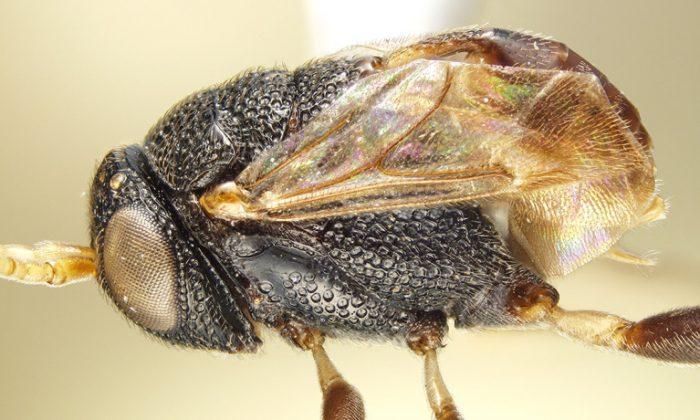Scientists have discovered several new species of threatened wasps in Sub-Saharan Africa that are the first known insects to fold the forewings transversely.
Only a few other insects—mainly some earwigs, cockroaches, and beetles—are capable of folding their hind wings transversely—along a line between the front and back wing margin—as opposed to longitudinal folding, which occurs along a line from the wing base to the wing tip, says Andy Deans, associate professor of entomology at Penn State.
“These other insects fold their wings transversely so that the wings can be shortened and tucked under a modified, shell-like fore wing,” he says. “This, however, is the first time anyone has observed an insect that folds its fore wings transversely.”
“Ensign wasps are predators of cockroach eggs, and the transverse folding exhibited by these species may enable them to protect their wings while developing inside the cramped environment of cockroach egg cases,” adds Deans. “It also may be useful while they are active in their cockroach prey’s leaf-litter environment.”
‘Diagnosing’ New Species
The researchers examined wasps belonging to the family Evaniidae from Sub-Saharan Africa. They named five new species and created an identification key for the new tribe, Trissevaniini.

“In our paper, we included a print, cut, and fold template for the readers that helps them and us to comprehend the simple, yet enigmatic, wing fold system of the new tribe,” says István Mikó. (Penn State)
“We didn’t know these new species existed until now, and at least two of them—Trissevania heatherae and T. mrimaensis—are found only in a small patch of forest in Kenya that is threatened by mining activity,” Deans says.
According to Deans, to officially give a new species a name one must, among other things, provide a diagnosis that describes how this species differs from others.
“In most cases, the diagnosis lists certain phenotypic aspects of the wasps, such as having a black head or fuzzy hind legs,” he says. “Diagnoses are typically written in natural language and using one’s own custom lexicon. There is no standard syntax to describe the way an organism looks, which makes these data difficult to extract in any large-scale way.”
To get around this problem, the researchers developed a technique that provides broadly accessible descriptions.
“The gist is that one could actually query across existing anatomy data using computers,” he says. “For example, one could search for all the species that have fuzzy heads, or all the species that have a patch of hairs on the ventral surfaces of their abdomens. One could then cross-reference the result with information about the surrounding environment, the cockroach host, or the evolutionary history of the wasp. The more we test and refine this approach the better we’ll understand its capabilities and utility.”
Origami Folds
In addition to photographing the wasps’ wings, the team used principles of origami paper folding to physically visualize the transverse folding of the wings.
“We used origami, one of the most ancient and simple art forms to understand the wing folding, which, based on our observations through microscopes was otherwise impossible to understand,” says István Mikó, research associate in entomology. “In our paper, we included a print, cut and fold template for the readers that helps them and us to comprehend the simple, yet enigmatic, wing fold system of the new tribe.”
According to Mikó, insect wings are common subjects of researchers who investigate bio-inspired technologies. The team’s results will be published in PLOS ONE.
“The relatively simple wing-folding mechanism of the new tribe can be utilized in advance technologies, such as applying morphing systems in aerospace vehicle research or expandable structural systems in space missions,” Mikó says.
Evolutionary History
The researchers says that by characterizing the phenotypes of these species of wasps, they are one step closer to understanding the evolutionary history of the family Evaniidae.
“Understanding the evolutionary history of this family of wasps is important because this knowledge will inform our attempts to reclassify the wasps in a way that is robust and predictive,” Deans says.
In the future, the team plans to use the same methods it developed to investigate other groups of wasps in the family Evaniidae as well as those in the lineage Ceraphronoidea, small wasps that parasitize many other groups of insects and for which very little is known about their diversity and morphology.
Other authors on the paper include researchers from the International Centre of Insect Physiology and Ecology, University of North Carolina, Chapel Hill, and Illinois Natural History Survey.
The National Science Foundation supported this research.
Source: Penn State. Republished from Futurity.org under Creative Commons License 3.0.
